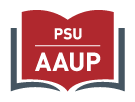Although you could be forgiven for missing the Provost’s PSU “Next” message that went out Friday evening, it deserves the full and considered attention of us all. Along with a series of presentations to the Faculty Senate and the Board of Trustees, it paints a gloomy picture of the state of PSU’s finances and cautions that some difficult choices need making. The options, as the Provost sees them, are widely distributed cuts, which will leave PSU as a “broadly diminished university,” or targeting programs for reduction, reorganization, or elimination. Only the latter course will preserve the “quality and character of PSU,” and so “this choice is not hard to make.” For the Provost, that may well be, but for many others of us, the choice will be considerably more difficult depending on our proximity to the chopping block.
As our last newsletter highlighted, although the financial challenges we face as a university are real, the urgency of drastic measures appear closely linked to dire enrollment forecasts over the next five years, and thus an expectation that tuition revenue will continue its pronounced decline. Most of us are not privy to the specifics of the enrollment forecasting model, but it is informed by the much publicized 28% percent drop in freshman applications for next fall and incorporates a further 5% decline in enrolled freshmen and transfer students. That’s three consecutive years of 5% enrollment declines – last year’s actual, this year’s estimated, and next year’s forecast. For 2022-23, the administration expects an additional 3% decline, followed by another 2% decline in 2023-24, and then a 1% decline in 2024-25. With an expected enrollment plunge approaching 17% from 2019 through 2025, yeah, be afraid. Be very afraid.
Okay, but like we said in our previous newsletter, we have some questions, and you should too.
- How exactly are these enrollment forecasts built, and what degree of uncertainty attaches to them?
- PSU has had to absorb the shock of the pandemic. Will we not experience a post-pandemic recovery?
As the Provost is right to observe, enrollments have suffered during the pandemic as “many of our students have lost the jobs that supported them going to college, have been mobilizing for racial justice, have cared for families, and have been challenged by remote learning.” But some of these effects are short-lived, unlike the longer-term demographic trends that may be contributing to the administration’s enrollment pessimism.
Although the Provost is grateful for the work of the Faculty Senate’s Ad Hoc Committee on Academic Program Reduction and Curricular Adjustments, we are put on notice that “it is the responsibility of the Provost and academic administration to engage in the difficult task of putting forward programs to be considered for possible reduction, reorganization, or elimination.” Those recommendations will be produced by a working group of deans, associate deans, assistant deans, and directors. Be that as it may, let’s remember that any major reduction, reorganization, or elimination of academic programs or departments requires action by the Faculty Senate, upon advice by the Educational Policy Committee. Further, any departmental reduction or elimination should also require a declaration from the President under Article 22, as has just occurred for the IELP, which provides for a robust process of faculty input about the problem, and the University’s plans for the solution.
We all need to get and stay engaged as this PSU “Next” initiative as it unfolds over the next few months. Our voices and authority as faculty and academic professionals are never more important than during times like these. Please attend the Budget Town Hall on February 22, 2:00-4:00 and be sure to submit questions to admin ahead of time.
